-
Countries
-
Data and Analysis
-
Special Focus
-
Crisis Responses

Contact
DTM Nigeria, iomnigeriadtm@iom.int
Language
English
Location
Nigeria
Period Covered
Apr 08 2024
Apr 14 2024
Activity
- Mobility Tracking
- Event Tracking
Between 8 and 14 April 2024, a total of 462 new arrivals were recorded at locations in Adamawa and Borno states. The new arrivals were recorded at locations in Askira/Uba, Bama, Gwoza, and Kala Balge Local Government Areas (LGAs) of the most conflict-affected Borno State, and in Fufore, Gombi, Hong, Madagali, and Michika LGAs of Adamawa State.
ETT assessments identified the following movement triggers: improved security (178 individuals or 38%), poor living conditions (124 individuals or 27%), family re-unification (88 individuals or 19%), seasonal farming (45 individuals or 10%), military operations (14 individuals or 3%) and fear of attack (13 individuals or 3%).
There was no movement recorded on 10 April 2024, as a result of the holiday marking the end of the Ramadan fast.
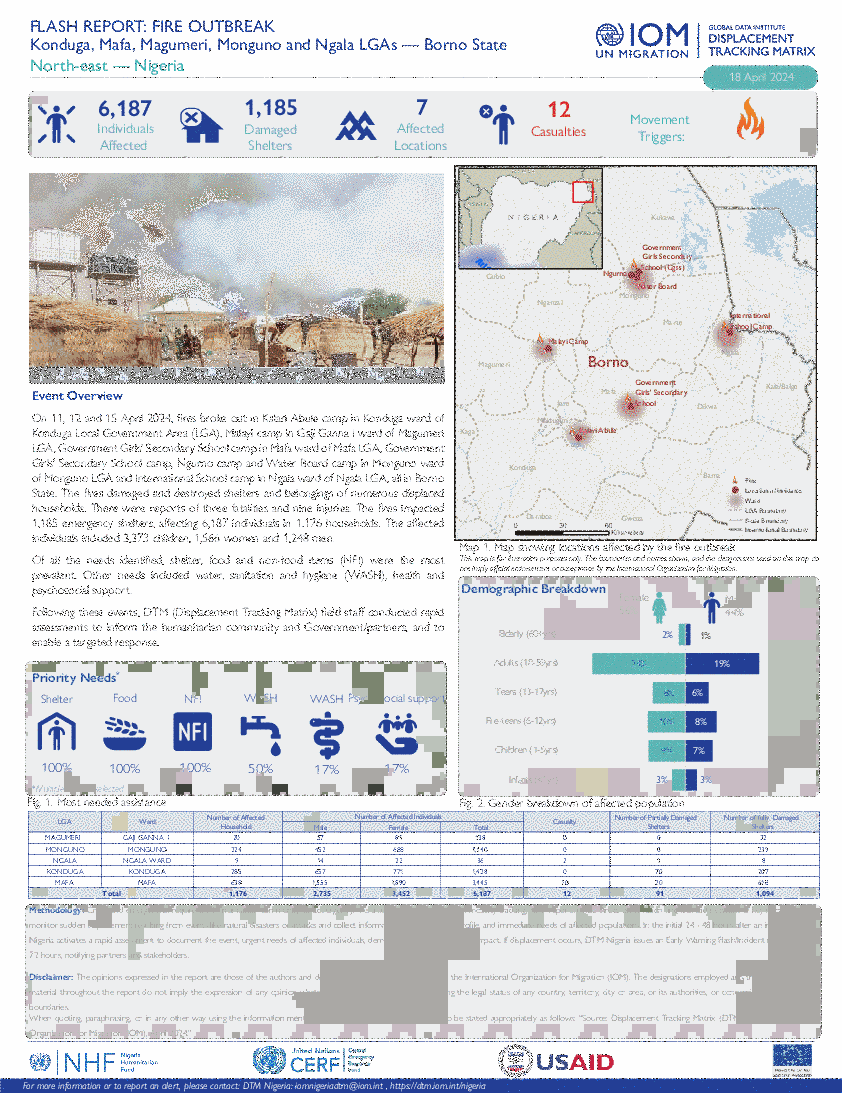
Contact
DTM Nigeria, iomnigeriadtm@iom.int
Language
English
Location
Nigeria
Period Covered
Apr 11 2024
Apr 15 2024
Activity
- Mobility Tracking
- Event Tracking
On 11, 12 and 15 April 2024, fires broke out in Kalari Abule camp in Konduga ward of Konduga Local Government Area (LGA), Malayi camp in Gaji Ganna I ward of Magumeri LGA, Government Girls’ Secondary School camp in Mafa ward of Mafa LGA, Government Girls’ Secondary School camp, Ngurno camp and Water Board camp in Monguno ward of Monguno LGA and International School camp in Ngala ward of Ngala LGA, all in Borno State. The fires damaged and destroyed shelters and belongings of numerous displaced households. There were reports of three fatalities and nine injuries. The fires impacted 1,185 emergency shelters, affecting 6,187 individuals in 1,176 households. The affected individuals included 3,373 children, 1,566 women and 1,248 men.

Contact
DTM Iraq, IraqDTM@iom.int
Language
English
Location
Iraq
Period Covered
May 01 2018
Sep 30 2021
Activity
- Mobility Tracking
- Baseline Assessment
From May 2018 to September 2021, 35,307 Iraqi returnees from abroad were identified in 17 Governorates, 69 Districts and 635 locations. During this reporting period, IOM Iraq achieved full country coverage.
Most of the returnees from abroad were recorded in the governorates of Ninewa (45%), Thi-Qar (42%) and Anbar (5%). Of those returnees recorded in Ninewa, 66 per cent were recorded in the district of Telafar, while 24 per cent were recorded in Sinjar. In Thi-Qar, 88 per cent were recorded in the district of Nassriya, while 7 per cent were recorded in Suq Al-Shoyokh. Finally, in Anbar, 51 per cent returned to the district of Ana while 26 per cent were in Al-Ka'im. The majority of returnees (56%) were identified as having come from two countries: Turkey (36%) and the Syrian Arab Republic (20%).
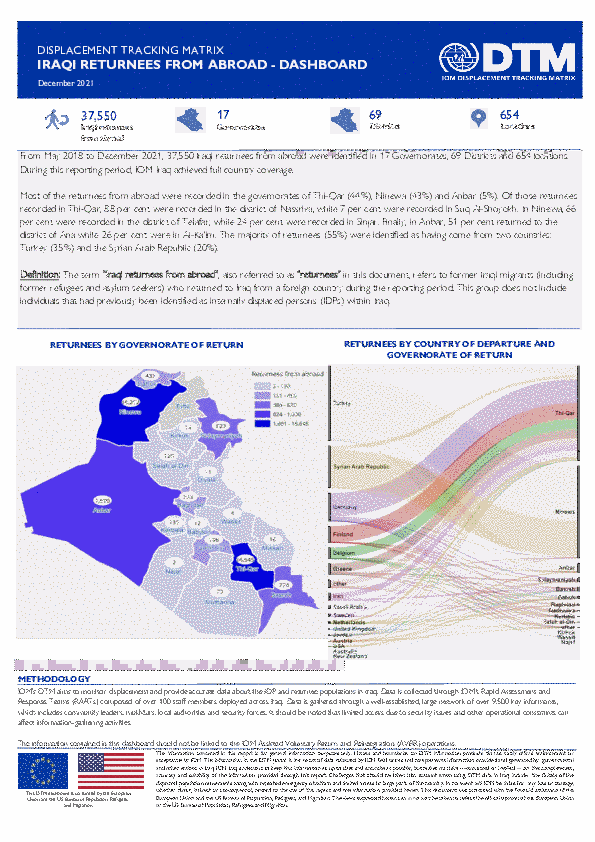
Contact
DTM Iraq, IraqDTM@iom.int
Language
English
Location
Iraq
Period Covered
May 01 2018
Dec 31 2021
Activity
- Mobility Tracking
- Baseline Assessment
From May 2018 to December 2021, 37,550 Iraqi returnees from abroad were identified in 17 Governorates, 69 Districts and 654 locations. During this reporting period, IOM Iraq achieved full country coverage.
Most of the returnees from abroad were recorded in the governorates of Thi-Qar (44%), Ninewa (43%) and Anbar (5%). Of those returnees recorded in Thi-Qar, 88 per cent were recorded in the district of Nassriya, while 7 per cent were recorded in Suq Al-Shoyokh. In Ninewa, 66 per cent were recorded in the district of Telafar, while 24 per cent were recorded in Sinjar. Finally, in Anbar, 51 per cent returned to the district of Ana while 26 per cent were in Al-Ka'im. The majority of returnees (55%) were identified as having come from two countries: Turkey (35%) and the Syrian Arab Republic (20%).

Contact
DTM Iraq, IraqDTM@iom.int
Language
English
Location
Iraq
Period Covered
May 01 2018
Mar 31 2022
Activity
- Mobility Tracking
- Baseline Assessment
From May 2018 to March 2022, 40,332 Iraqi returnees from abroad were identified in 17 Governorates, 69 Districts and 664 locations. During this reporting period, IOM Iraq achieved full country coverage.
Most of the returnees from abroad were recorded in the governorates of Thi-Qar (46%), Ninewa (42%) and Anbar (4%). Of those returnees recorded in Thi-Qar, 88 per cent were recorded in the district of Nassriya, while 7 per cent were recorded in Suq Al-Shoyokh. In Ninewa, 64 per cent were recorded in the district of Telafar, while 22 per cent were recorded in Sinjar. Finally, in Anbar, 51 per cent returned to the district of Ana while 26 per cent were in Al-Ka'im. The majority of returnees (51%) were identified as having come from two countries: Turkey (33%) and the Syrian Arab Republic (18%).
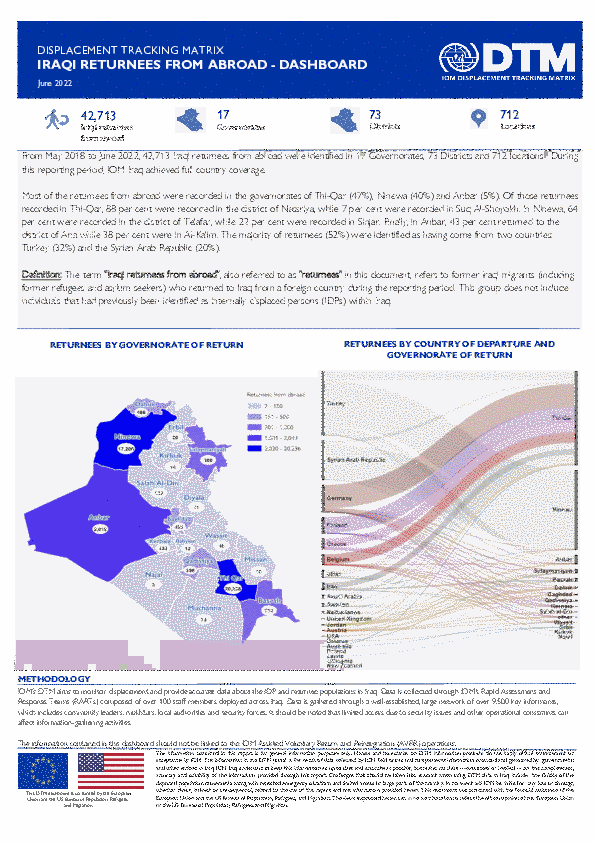
Contact
DTM Iraq, IraqDTM@iom.int
Language
English
Location
Iraq
Period Covered
May 01 2018
Jun 30 2022
Activity
- Mobility Tracking
- Baseline Assessment
From May 2018 to June 2022, 42,713 Iraqi returnees from abroad were identified in 17 Governorates, 73 Districts and 712 locations. During this reporting period, IOM Iraq achieved full country coverage.
Most of the returnees from abroad were recorded in the governorates of Thi-Qar (47%), Ninewa (40%) and Anbar (5%). Of those returnees recorded in Thi-Qar, 88 per cent were recorded in the district of Nassriya, while 7 per cent were recorded in Suq Al-Shoyokh. In Ninewa, 64 per cent were recorded in the district of Telafar, while 22 per cent were recorded in Sinjar. Finally, in Anbar, 43 per cent returned to the district of Ana while 38 per cent were in Al-Ka'im. The majority of returnees (52%) were identified as having come from two countries: Turkey (32%) and the Syrian Arab Republic (20%).
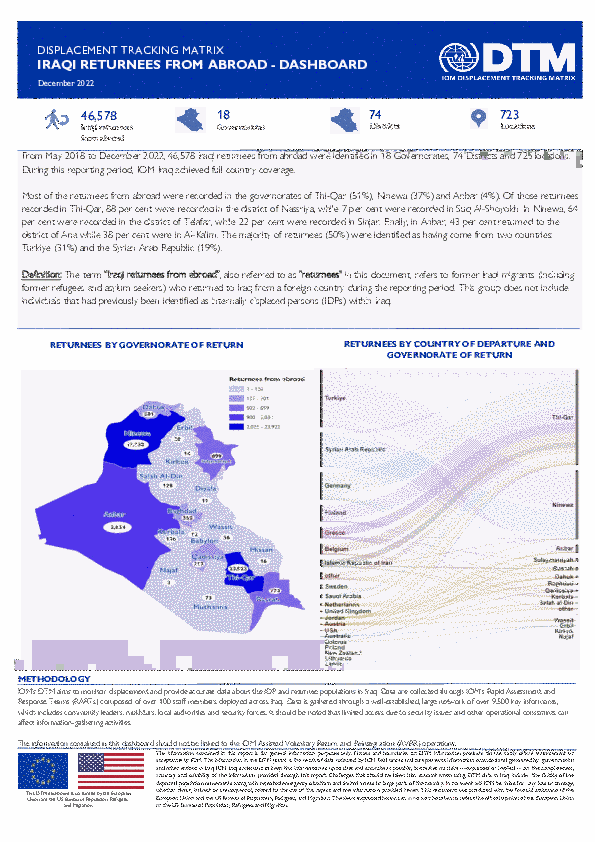
Contact
DTM Iraq, IraqDTM@iom.int
Language
English
Location
Iraq
Period Covered
May 01 2018
Dec 31 2022
Activity
- Mobility Tracking
- Baseline Assessment
From May 2018 to December 2022, 46,578 Iraqi returnees from abroad were identified in 18 Governorates, 74 Districts and 723 locations. During this reporting period, IOM Iraq achieved full country coverage.
Most of the returnees from abroad were recorded in the governorates of Thi-Qar (51%), Ninewa (37%) and Anbar (4%). Of those returnees recorded in Thi-Qar, 88 per cent were recorded in the district of Nassriya, while 7 per cent were recorded in Suq Al-Shoyokh. In Ninewa, 64 per cent were recorded in the district of Telafar, while 22 per cent were recorded in Sinjar. Finally, in Anbar, 43 per cent returned to the district of Ana while 38 per cent were in Al-Ka'im. The majority of returnees (50%) were identified as having come from two countries: Turkiye (31%) and the Syrian Arab Republic (19%).
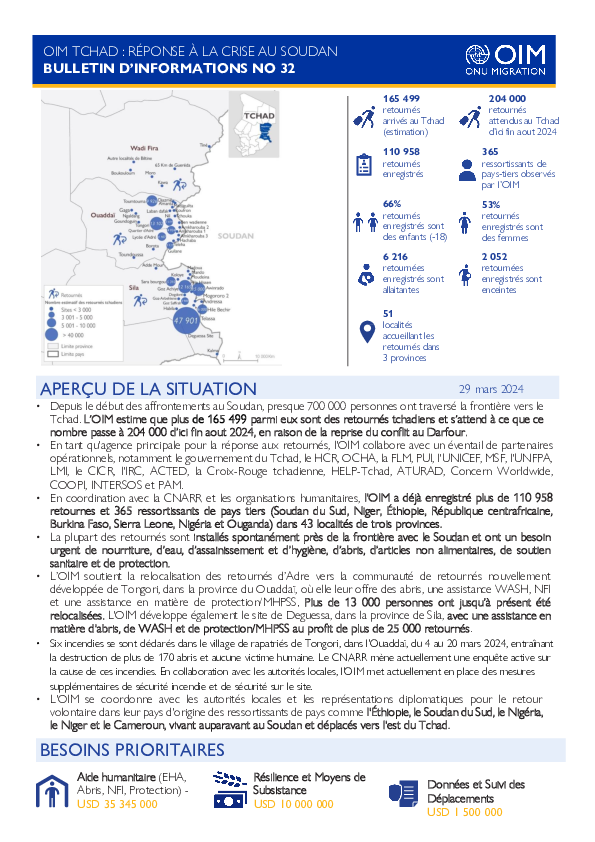
Contact
DTM Iraq, IraqDTM@iom.int
Language
English
Location
Iraq
Period Covered
May 01 2018
Apr 30 2023
Activity
- Mobility Tracking
- Baseline Assessment
From May 2018 to April 2023, 48,536 Iraqi returnees from abroad were identified in 18 Governorates, 74 Districts and 726 locations. During this reporting period, IOM Iraq achieved full country coverage. Most of the returnees from abroad were recorded in the governorates of Thi-Qar (53%), Ninewa (36%) and Anbar (4%). Of those returnees recorded in Thi-Qar, 88 per cent were recorded in the district of Nassriya, while 7 per cent were recorded in Suq Al-Shoyokh. In Ninewa, 64 per cent were recorded in the district of Telafar, while 22 per cent were recorded in Sinjar. Finally, in Anbar, 42 per cent returned to the district of Ana while 38 per cent were in Al-Ka'im. The majority of returnees (48%) were identified as having come from two countries: Turkey (30%) and the Syrian Arab Republic (18%).
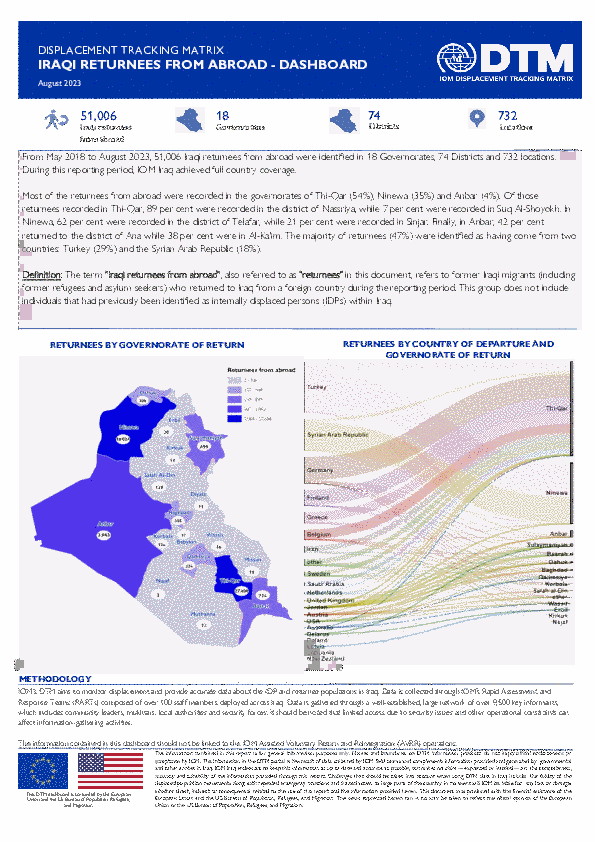
Contact
DTM Iraq, IraqDTM@iom.int
Language
English
Location
Iraq
Period Covered
May 01 2018
Aug 01 2023
Activity
- Mobility Tracking
- Baseline Assessment
From May 2018 to August 2023, 51,006 Iraqi returnees from abroad were identified in 18 Governorates, 74 Districts and 732 locations. During this reporting period, IOM Iraq achieved full country coverage. Most of the returnees from abroad were recorded in the governorates of Thi-Qar (54%), Ninewa (35%) and Anbar (4%). Of those returnees recorded in Thi-Qar, 89 per cent were recorded in the district of Nassriya, while 7 per cent were recorded in Suq Al-Shoyokh. In Ninewa, 62 per cent were recorded in the district of Telafar, while 21 per cent were recorded in Sinjar. Finally, in Anbar, 42 per cent returned to the district of Ana while 38 per cent were in Al-Ka'im. The majority of returnees (47%) were identified as having come from two countries: Turkey (29%) and the Syrian Arab Republic (18%).
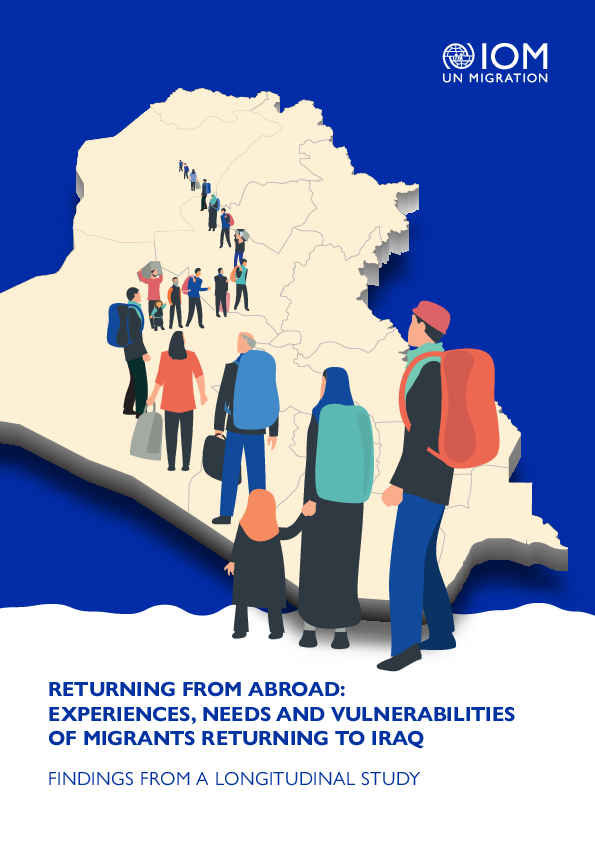
Contact
IraqDTM@iom.int
Language
English
Location
Iraq
Period Covered
Aug 01 2020
Aug 31 2021
Activity
- Survey
- Flow Monitoring
Migration from Iraq is multifaceted, characterized by different flows of emigration. In the post-2003 period, Iraqi nationals were mostly migrating to neighbouring countries, such as Jordan, Syria, Lebanon, and Iran. In the following years, outgoing migration has turned towards Turkey and countries outside the region, such as the United States, Canada, and Australia, as well as European countries like Germany, Greece and Finland. Migration has been connected to waves of conflict-driven displacement resulting from the Iraq-Iran War (1980-1988), the Gulf War (1990-1991), the US occupation of Iraq and sectarian war (2003-2011), and the armed conflict against the Islamic State of Iraq and the Levant (2013-2017). Beyond fuelling international movements, the latter conflict also resulted in around 6 million of internally displaced people. Throughout these periods, migration has been used as a strategy to overcome economic instability, political unrest, and the lack of security, equality, and social justice in Iraq; however, others have migrated abroad for economic, health or business reasons.
Iraqi migrants are estimated to be more than 2 million, and return migration from abroad is an increasingly important dimension of the Iraqi migration landscape. After the end of the sectarian war and the conflict against the Islamic State, many Iraqis decided to return voluntarily. Moreover, among those who have emigrated as asylum seekers, not all of them have obtained a protection status (such as refugee status) that allows them to remain in the host country; frequently, such people are hence forced to return to Iraq. As of December 2022, approximately five million Iraqi nationals have returned from abroad. However, the exact number of Iraqi returnees is difficult to establish because not all of them have returned through programmes of assisted voluntary return and flows are thus difficult to track. Little is known about the conditions faced by returned migrants in Iraq. Due to the lack of statistical data and research, it is not possible to have a comprehensive picture of the challenges faced by nationals upon return, or their challenges of reintegrating in Iraq.